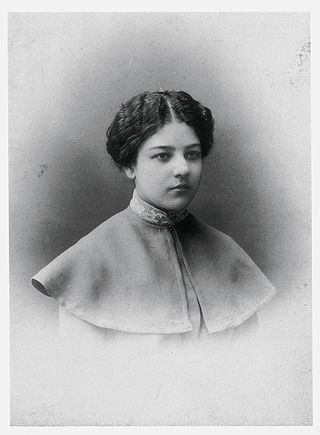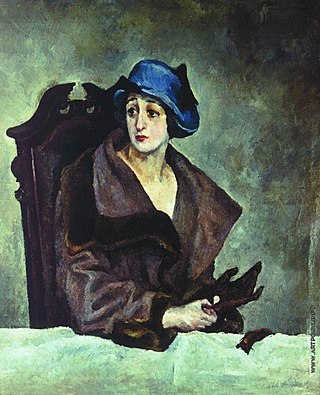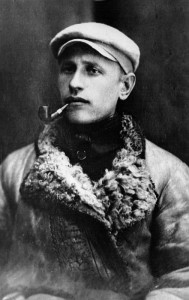Related Research Articles

Marc Chagall was a Jewish Belarusian and French artist. An early modernist, he was associated with several major artistic styles and created works in a wide range of artistic formats, including painting, drawings, book illustrations, stained glass, stage sets, ceramics, tapestries and fine art prints.

Léon Bakst – born as Leyb-Khaim IzrailevichRosenberg, Лейб-Хаим Израилевич (Самойлович) Розенберг was a Russian painter and scene and costume designer of Jewish origin. He was a member of the Sergei Diaghilev circle and the Ballets Russes, for which he designed exotic, richly coloured sets and costumes. He designed the décor for such productions as Carnaval (1910), Spectre de la rose (1911), Daphnis and Chloe (1912), The Sleeping Princess (1921) and others.

The Russian avant-garde was a large, influential wave of avant-garde modern art that flourished in the Russian Empire and the Soviet Union, approximately from 1890 to 1930—although some have placed its beginning as early as 1850 and its end as late as 1960. The term covers many separate, but inextricably related, art movements that flourished at the time; including Suprematism, Constructivism, Russian Futurism, Cubo-Futurism, Zaum, Imaginism, and Neo-primitivism. Many of the artists who were born, grew up or were active in what is now Belarus and Ukraine, are also classified in the Ukrainian avant-garde.

The Moscow Museum of Modern Art is a museum of modern and contemporary art located in Moscow, Russia. It was opened to public in December 1999. The project of the museum was initiated and executed by Zurab Tsereteli, president of the Russian Academy of Arts. In 2018, The Vadim Sidur Museum and Museum-Studio of Dmitry Nalbandyan merged into the Moscow Museum of Modern Arts.

Olga Vladimirovna Rozanova was a Russian avant-garde artist painting in the styles of Suprematism, Neo-Primitivism, and Cubo-Futurism.

Soyuz Molodyozhi was an artistic group and an art magazine of Russian avant-garde organized in 1910. There were more than 30 members of the group and most of other Russian avant-garde participated in their exhibitions.

Léopold Frédéric Léopoldowitsch Survage was a Russian-French painter of Finnish origin. Trained in Moscow, he identified with the Russian avant-garde before moving to Paris, where he shared a studio with Amedeo Modigliani and experimented with abstract movies. He also gained commissions for Serge Diaghilev's Ballets Russes.

Alexander Alexandrovich Osmerkin was a Russian painter, graphic artist, stage designer, and art teacher. He was a member of the Knave of Diamonds avant-garde group, AKhRR, and Society of Moscow Artists (OMKh) groups. Since 1932 he was a member of the Leningrad Union of Artists.

The Marc Chagall Museum is a museum dedicated to the painter Marc Chagall, in his hometown of Vitebsk, Belarus. The museum was founded by the decision of the Vitebsk City Executive Committee on October 23, 1991.
The Marinko Sudac Collection, based in Zagreb, Croatia, has been created with a clear collecting strategy based on the region of Central and Eastern Europe, additionally spanning from the Baltic area to the Black Sea. The guiding principle of the Collection is systematic exploration, researching, and promotion of the avant-garde practices which have been marginalized, forbidden, and at times completely negated due to the historical, social and political circumstances. In this context, the Marinko Sudac Collection gives the most complete and comprehensive overview on the art of this region. The Collection starts at 1909, and it show the continuity from the first Avant-Gardes, through neo-avant-garde and New Artistic Practices, ending with the fall of the Berlin Wall. The global uniqueness of the Marinko Sudac Collection is also seen in the kind of media it contains. It contains not only traditional artworks, such as paintings, sculptures, and photographs, but it gives equal importance to documentary and archival material. Great importance is put on these almost forgotten media, which enable research of specific phenomena, artists and the socio-political situation which affected this type of art. The Collection contains a great number of museological units, and it treats the documentary and archival material on the same level as traditional artworks. By examining the units contained in the Marinko Sudac Collection, one can read not only the art scene or the art production of a certain artist, but the full status of the society, the socio-political atmosphere of the region in which this art was created in.
The World Holocaust Forum is a series of events aimed at preserving the memory of the Holocaust. It is also known as the "Let My People Live!" Forum.

The European Council on Tolerance and Reconciliation is a non-governmental organization that was established in Paris, France on 7 October 2008 to monitor tolerance in Europe. The chairman of the council is former British Prime Minister Tony Blair, and the President of the council is Viatcheslav Moshe Kantor. Sebastian Kurz, former chancellor of Austria, joined the council as a co-chairman in January 2022.
The International Luxembourg Forum on Preventing Nuclear Catastrophe — is an international non-governmental organisation uniting leading world-renowned experts on non-proliferation of nuclear weapons, materials and delivery vehicles.

Viatcheslav Moshe Kantor is a Russian businessman.
The European Jewish Fund (EJF) is an international non-governmental organisation that coordinates and supports programmes and events aimed at improving interreligious and interethnic relations, reinforcing Jewish identity, counteracting assimilation, promoting tolerance and reconciliation in Europe, fighting against xenophobia, extremism and antisemitism, and preserving the memory of the Holocaust. The EJF was established in 2006 on the initiative of Viatcheslav Moshe Kantor, who is President of the European Jewish Congress and EJF Chairman. Ariella Woitchik is EJF Secretary General.
Igor Vitalyevich Savitsky was a Ukrainian-born painter, archeologist and collector, especially of avant-garde art. He single-handedly founded the State Art Museum of the Republic of Karakalpakstan, named after I. V. Savitsky, an art museum based in Nukus, Uzbekistan.

Soviet art is the visual art style produced after the Russian Revolution of 1917 and during the existence of the Soviet Union, until its collapse in 1991. The Russian Revolution led to an artistic and cultural shift within Russia and the Soviet Union as a whole, including a new focus on socialist realism in officially approved art.

Baku Museum of Modern Art is a museum of modern art located in Baku, Azerbaijan.

Elizabeth A. T. Smith is an American art historian, museum curator, writer, and presently the executive director of the Helen Frankenthaler Foundation. She has formerly held positions as a curator at the Los Angeles Museum of Contemporary Art (MoCA), the chief curator and deputy director of programs at the Museum of Contemporary Art, Chicago, and the executive director, curatorial affairs, at the Art Gallery of Ontario. She is the author of numerous books on art and architecture, including Blueprints for Modern Living: History and Legacy of the Case Study Houses; Lee Bontecou: A Retrospective, Helen Frankenthaler: Composing with Color, 1962–63, and many others.

Karl Johansson was a Latvian-Soviet avant-garde artist.
References
- ↑ Address by Viatcheslav Moshe Kantor Archived July 14, 2011, at the Wayback Machine , opening of the Museum of Avant-Garde Mastery exhibition My Homeland is within My Soul: Art without Borders, Geneva, June 11, 2009.
- ↑ «You Cannot Buy What You Really Want Without Paying Too Much». Excerpts from Viatcheslav Kantor's interview to Forbesrussia.ru, 26.01.2010
- ↑ MAGMA Museum Exhibitions
- ↑ President of the Museum of Avant-Garde Mastery Viatcheslav Kantor elected Honorary Member of the Russian Academy of Arts